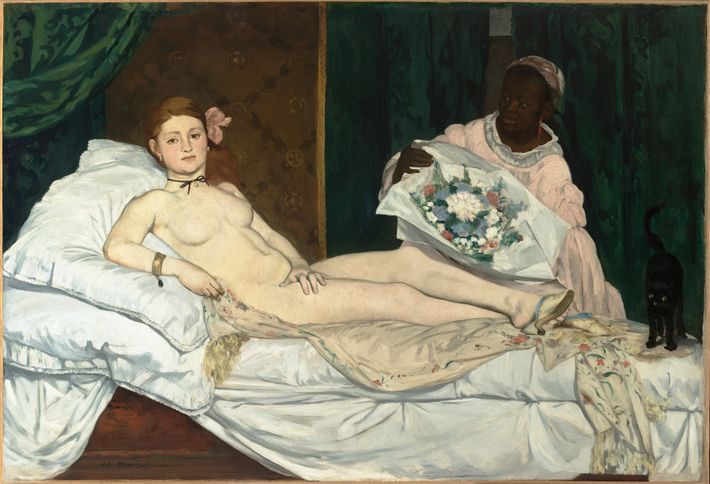It is a cliché: the work of art that scandalizes audiences upon its debut, only to get its due once the shock of the new fades away. Édouard Manet’s 1863 masterpiece Olympia, the star of the Metropolitan Museum of Art’s gigantic new show “Manet/Degas,” in some respects fits this description. It was attacked when it was first exhibited at a salon in Paris in 1865, described as “ugly and repulsive” and “rancid.” Its subject, a nude courtesan who looks right at the viewer while a Black maid looks at her, was called a “female gorilla.” The painting was rehung near the ceiling to hide it from appalled critics, and it never sold during Manet’s lifetime. However, the difference between Olympia and other great works of art that initially faced comparable revulsion is that Olympia shocks still.
Manet was only 33 when Olympia received its rude welcome, but he had already established himself as a rule-breaker and a provocateur with the exhibition two years earlier of The Luncheon on the Grass, which featured two rakish men in modern dress and two women, one of them nude, in an Edenic landscape. Olympia was similarly perverse. While audiences were likely used to paintings of nudes — the courtesan’s languid pose appears to be based on Titian’s Venus of Urbino, which was painted in the 1530s — it was another thing to suggest that this slender jezebel was a Venus herself. Manet’s painting was seen as an offense, an affront, a joke. (Manet wrote to Baudelaire looking for comfort. The poet told him to take it on the chin: “Do you think you are the first man put in this predicament?”)
Viewers had come expecting handsome renderings of light and shadow done with little to no brushwork showing. But Olympia is not smooth or easy. The composition is awkward, exaggerated, blocky. The colors are harsh and high contrast, especially the two figures — one a creamy white, the other nearly as dark as the Japonisme backdrop — that dominate the painting’s shallow space. Olympia represents the beginning of the modern mind, the birth of a new consciousness. What shocks us now, though, is that servant and her enigmatic gaze, which seems to cast the whole order of the universe into fresh doubt.
The model for the courtesan is Victorine Meurent, who posed for Manet many times, including for Luncheon. Her nakedness is blatant, audacious, expunged of the godly glow that characterizes Titian’s Venus and other idealized mythic subjects. Her expression is unashamed and confrontational, so different from those of the passive odalisques that came before her. She reclines on a bed of white silken pillows and sheets, propped up on her right elbow. One hand holds a flowered shawl, but the other, covering her pudenda, is where the eye immediately goes. We are stopped here. So close, so far, so challenging, so “What are you looking at?” She wears a black bow adorned with a pendant around her neck while she kicks off one slipper, undressing before our eyes. Her whole demeanor is an invitation to approach and a warning to stay away. A black cat at her feet looks directly at us with big staring eyes and arches its back.
The Black model is Laure. We do not know her last name, though like Meurent she posed for Manet multiple times. She is dressed in a light pink, holding a bouquet of flowers. If Meurent is a representative of sex, decadence, and freethinking, then Laure looks on inscrutably, a silent supplicant, witness, judge. The artist Lorraine O’Grady has written that Laure was “made to disappear into the background drapery,” that “she is not a real person, only a robotic servant,” and that she is “not permitted to make us feel guilty, to accuse us as does the slave in Toni Morrison’s Beloved.” There is, indeed, something troubling even now — perhaps especially now — about her appearance and disposition, and it would be easy to cast her as an unconscious symbol of racial inequity, caste hierarchies, and narrowness of mind. After all, only the white body is meant to be admired and desired here. In comparison, the Black body can be seen as a prop, a human vase to exhibit the flowers.
But Manet has not painted her crudely or without tenderness, and there is an awareness of Laure’s presence and her thoughts as she looks upon Meurent’s prone figure. How deep that awareness may be is impossible to say, though on a visit to Brazil as a 16-year-old, Manet wrote, “All these wretched people appear overwhelmed; the power that the whites have over them is extraordinary … but as slaves they are not allowed shoes.” He described Laure in his journal as being “very beautiful.”
Manet was born into wealth. His mother was the daughter of a diplomat and the goddaughter of Swedish royalty. His father was a magistrate and head of personnel at the Ministry of Justice. Manet veered from that path and pursued painting. He is a master of the color black; few artists have ever painted such rich combinations of this shade. His brush handling is simultaneously studied and quick, deft and unpredictable. He was instrumental in breaking the strangle-hold on painting that was classic western perspective. Before him, there had been Delacroix, Turner, Corot, Courbet, and others. After Manet, art was up for grabs.
Although it took a long time for western audiences to even see Laure properly, there is something in her pose that breaks with other conventions of perspective. Like the viewer, she is looking at Meurent. But the viewer can see her too. So here lies another reading of the painting: It is almost as if Manet were asking us to see the courtesan, this modern Venus representing the depths and peaks of European culture, through another set of eyes, dimly glimpsed in the background.
“Manet/Degas” opens September 24 at Metropolitan Museum of Art.






